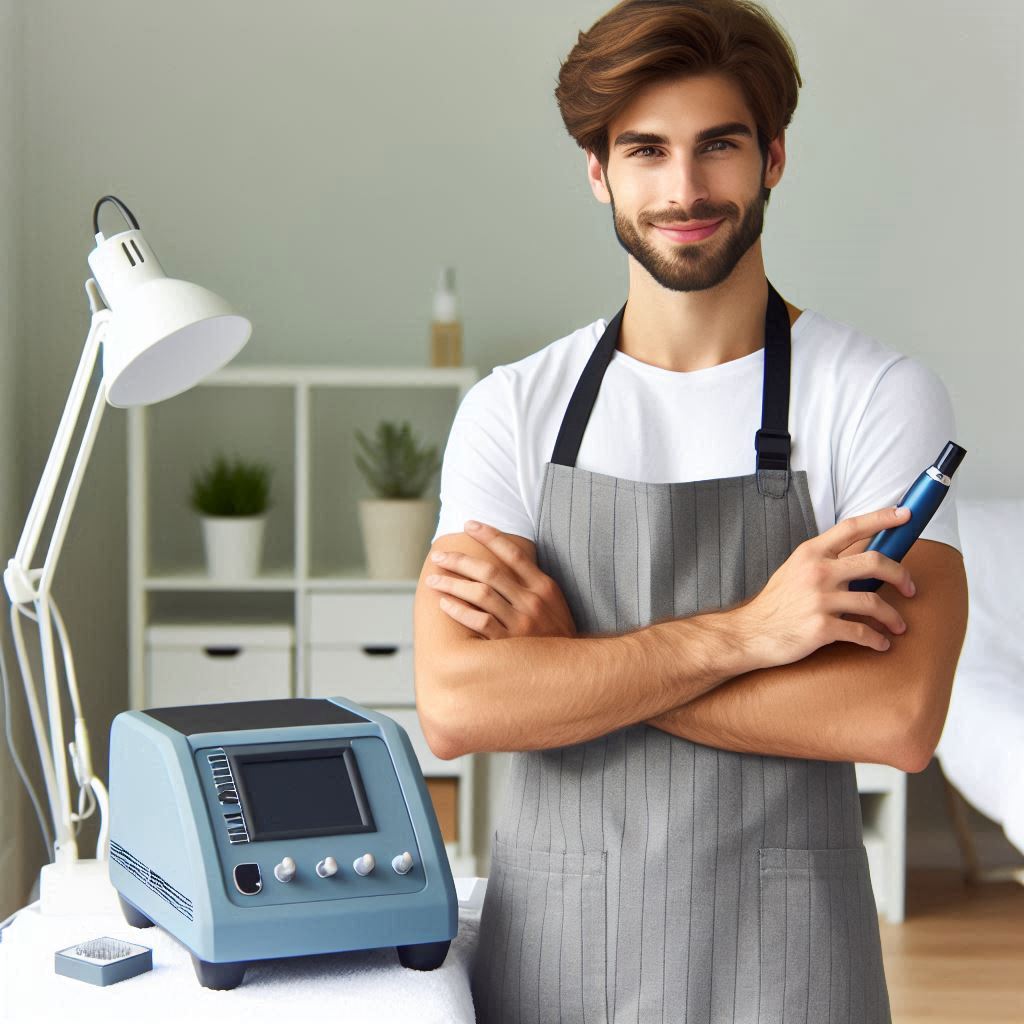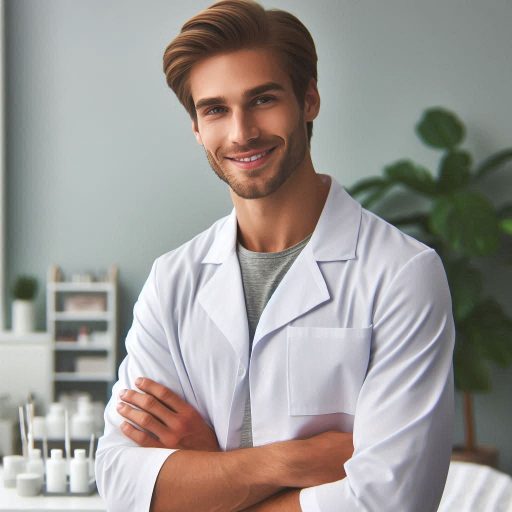Introduction
Estheticians are beauty professionals who provide skincare services to clients, including facials, waxing, and skincare treatments.
Their role is crucial in helping clients achieve healthy and glowing skin.
Health and safety practices in the esthetics industry are essential to protect both estheticians and clients from potential risks and hazards.
These practices ensure a safe and hygienic environment for all involved.
Establishing a Safe Work Environment
As an esthetician, creating a safe work environment is essential for both your clients and yourself.
Here are some key practices to consider:
Setting up a clean and organized workspace
Keep your workspace tidy by regularly cleaning and disinfecting all surfaces.
This includes countertops, tables, and any equipment used during treatments.
Having a clutter-free environment not only looks more professional but also reduces the risk of accidents.
Ensuring proper ventilation and lighting
Good ventilation is crucial in an esthetician’s workspace to prevent the buildup of chemicals, fumes, and bacteria.
Make sure to open windows or use an air purifier to maintain fresh air circulation.
Additionally, adequate lighting is necessary to perform treatments effectively and spot any potential hazards.
Implementing protocols for sanitizing tools and equipment
Sanitizing your tools and equipment is non-negotiable when it comes to health and safety practices.
Develop strict protocols for cleaning and disinfecting all instruments used in treatments, such as tweezers, scissors, and extraction tools.
Make sure to follow manufacturer guidelines and use hospital-grade disinfectants to kill germs effectively.
Overall, by establishing a safe work environment through cleanliness, proper ventilation, and sanitation protocols, you can create a space where both you and your clients feel comfortable and protected.
Read: Esthetician Community: Support and Resources
Personal Hygiene and Protective Measures
Proper handwashing techniques
Regularly wash hands with soap and water for at least 20 seconds before and after each client.
Use hand sanitizer with at least 60% alcohol if soap and water are not available.
Avoid touching your face, eyes, or mouth during treatments to prevent cross-contamination.
Transform Your Career Today
Unlock a personalized career strategy that drives real results. Get tailored advice and a roadmap designed just for you.
Start NowUse of personal protective equipment such as gloves, masks, and aprons
Always wear disposable gloves when performing facials, extractions, or any procedure that involves contact with bodily fluids.
Wear a mask to protect yourself and clients from airborne particles and droplets during treatments.
An apron or smock can protect your clothing from spills and stains while working with products.
Guidelines for maintaining personal hygiene
Shower daily and wear clean, professional attire to maintain a clean and polished appearance.
Keep hair tied back and away from the face to prevent it from coming into contact with clients or products.
Avoid wearing jewelry that could harbor bacteria or get caught in equipment during treatments.
Regularly clean and sanitize your tools, equipment, and work surfaces to prevent the spread of bacteria and infections.
Properly dispose of single-use items and clean reusable items thoroughly before and after each use.
Read: Esthetician vs. Cosmetologist: Key Differences
Client Consultation and Skin Assessments
Importance of thorough client consultations
Thorough client consultations are essential for estheticians to understand the client’s needs, concerns, and expectations.
It helps in customizing treatments and ensuring client satisfaction.
Conducting skin assessments to identify potential allergies or skin sensitivities
Before performing any skincare treatment, estheticians should conduct a comprehensive skin assessment to identify any potential allergies or sensitivities the client may have.
This helps in selecting appropriate products and techniques to avoid adverse reactions.
Inquiring about medical history and current medications
Estheticians should inquire about the client’s medical history and current medications as certain health conditions or medications may impact the choice of treatments or products used.
It is crucial to ensure the client’s safety and well-being during the skincare service.
Read: How to Build a Loyal Client Base as a Massage Therapist

Safe Use of Chemicals and Products
Understanding the ingredients in skincare products
Estheticians must be knowledgeable about the components of the products they use on clients.
It’s important to understand the purpose and possible side effects of each ingredient.
Always check for potential allergens to ensure the safety of clients with sensitive skin.
Showcase Your Business Today
Reach thousands of readers actively exploring professional services. Publish your business profile and grow your audience now.
Publish NowPatch testing new products on clients
Before applying a new product to a client’s skin, perform a patch test.
Apply a small amount of the product on a small area of the skin to check for any adverse reactions.
Monitor the area for at least 24 hours to ensure there is no irritation or redness.
Proper storage and disposal of chemicals
Store chemicals and products in a cool, dry place away from direct sunlight.
Keep products sealed tightly to prevent contamination and deterioration of the ingredients.
Follow local regulations for the disposal of chemicals and expired products to protect the environment.
By following these health and safety practices, estheticians can ensure the well-being of their clients and maintain a professional standard of care in their practice.
Read: How to Price Your Esthetician Services
Gain More Insights: Career Alternatives for Former Baggage Handlers
See Related Content: Balancing Work and Life as a Bus Driver: Tips and Tricks
Preventing Cross-Contamination
Using Disposable Items Whenever Possible
One of the most effective ways to prevent cross-contamination in your esthetician practice is to use disposable items whenever possible.
Items such as disposable gloves, cotton pads, and facial wipes should be used for one client and then discarded to avoid transferring any germs or bacteria from one client to another.
Cleaning and Disinfecting Reusable Tools and Equipment
For tools and equipment that cannot be disposed of after each use, it is crucial to properly clean and disinfect them to prevent cross-contamination.
Use an appropriate cleaning solution and follow the manufacturer’s instructions for disinfecting tools such as tweezers, extractors, and facial steamers.
Implementing Proper Laundry Procedures for Linens and Towels
Linens and towels used during esthetician treatments should be washed thoroughly to remove any germs or bacteria.
Use hot water and a disinfecting laundry detergent to ensure that all linens and towels are sanitized properly.
Make sure to dry them completely before using them again.
Explore Further: Understanding the Real Estate Agent Job Market
Find Out More: Library Assistant: Key Challenges and Rewards
Emergency Preparedness
During emergencies, it is crucial for estheticians to be prepared to handle various situations that may arise in their workplace.
Here are some key steps to ensure the safety and well-being of both clients and staff:
Training Employees on Emergency Response Procedures
- Provide thorough training on how to respond to different emergency situations.
- Practice drills regularly to ensure that everyone knows what to do in case of an emergency.
- Designate roles and responsibilities for each team member during emergencies.
- Keep updated contact information for all employees in case of an emergency.
Having a Well-Stocked First Aid Kit on Hand
- Regularly check and restock the first aid kit with essential supplies.
- Ensure that the first aid kit is easily accessible to all staff members.
- Include items such as bandages, antiseptic wipes, gloves, and emergency contact numbers.
- Train employees on how to properly use the items in the first aid kit.
Knowing When to Contact Emergency Services
- Educate employees on when it is necessary to contact emergency services.
- Make sure that staff members know how to communicate effectively with emergency responders.
- Have clear protocols in place for contacting emergency services, such as calling 911.
- Train employees to provide essential information to emergency services, such as the location of the incident.
By following these emergency preparedness practices, estheticians can create a safe and secure environment for both their clients and staff.
It is essential to be proactive and ready to respond effectively in any emergency situation that may arise.
Conclusion
Health and safety practices for estheticians are crucial to ensure client well-being.
It is essential for estheticians to stay updated on industry standards and regulations to provide top-notch services.
Estheticians play a vital role in ensuring client safety and should always prioritize health and safety practices.
[E-Books for Sale]
The Big Book of 500 High-Paying Jobs in America: Unlock Your Earning Potential
$19.99 • 500 High-Paying Jobs • 330 pages
Explore 500 high-paying jobs in America and learn how to boost your career, earn more, and achieve success!
See All 500 High-Paying Jobs of this E-Book
1001 Professions Without a Degree: High-Paying American Jobs You Can Start Now
$19.99 • 1001 Professions Without a Degree • 174 pages
Discover 1001 high-paying jobs without a degree! Unlock career tips, skills, and success strategies for just $19.99!




